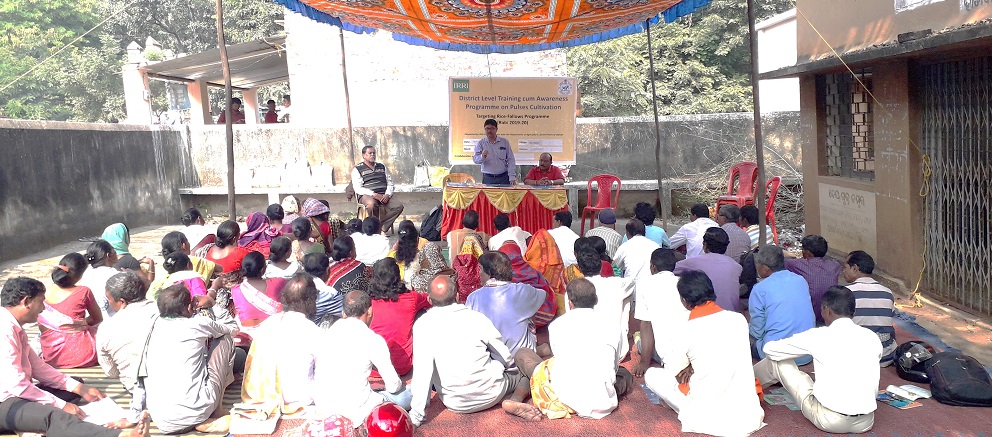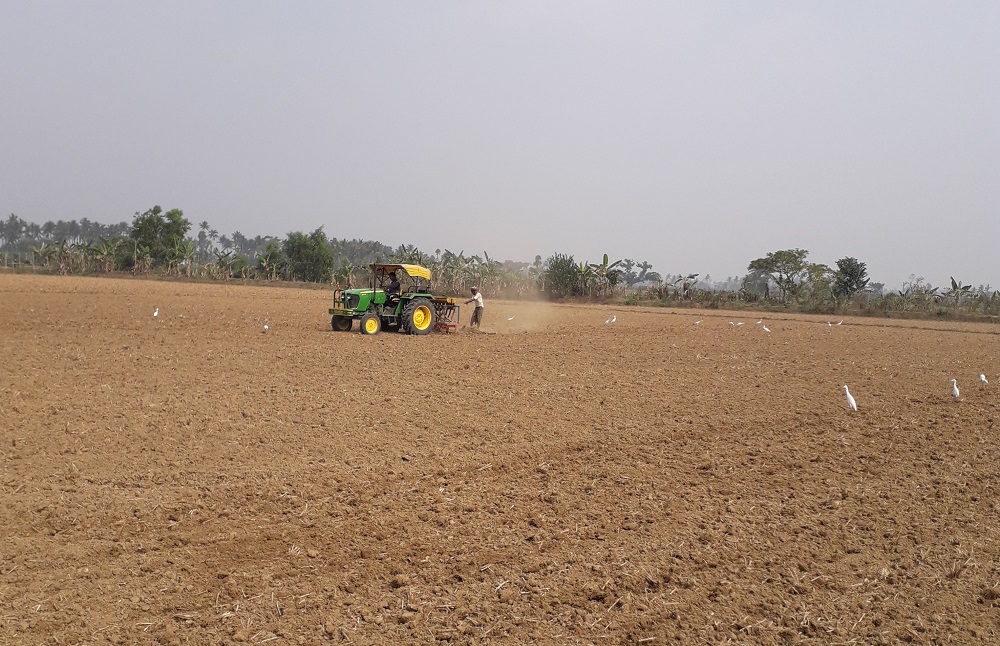Increasing cropping intensity in fallow lands could substantially improve food production and enhance the livelihoods of rural communities in Odisha.


The Indian State of Odisha has about 6.5 million hectares (ha) of cultivable land, 3.8 million ha of which is planted to rice, the main crop of the state. However, nearly 2 million ha of potentially productive cropland in Odisha remains fallow during the winter (rabi) season following the monsoon (kharif) rice season due to several constraints including:
- Lack of irrigation in many parts of the State
- Lack of residual moisture after the rice harvest in uplands and medium lands
- Excess moisture after the rice harvest in lowlands which delay planting rabi crops
- Cultivation of long duration paddy varieties leaves little time for a second crop
- Limited availability of short duration, high yielding and stress-tolerant rice and pulse varieties and good quality seed
- Lack of knowledge and experience in cultivating Rabi crops and limited extension effort to promote appropriate varieties and management practices
- Open grazing of cattle during the dry season
The late harvesting of kharif crops due to the cultivation of long duration paddy varieties in turn delays rabi planting gives limited scope for the enhancement of soil fertility through fixation of atmospheric nitrogen that subsequently results in low productivity. This poses a major challenge for the state in increasing the productivity and profitability of the agricultural lands.
Unlocking the fallow land potential
Increasing cropping intensity in fallow lands could substantially improve food production and enhance the livelihoods of rural communities in Odisha.
It is possible to bring a significant amount of rice-fallow area under a double-cropping system with improved agronomy and water management practices. A study was conducted to develop an integrated approach using geospatial technology and improved management practices for targeting rice-fallow areas efficiently and effectively.
The availability of rice varieties tolerant to drought, flood, and salinity; availability of short-duration pulse crops; improved agronomy, water management, mechanization; and targeting these technologies through GIS and remote-sensing technology can play a significant role in turning the fallow rice fields into cultivated lands. After the harvest of kharif paddy, fields with sufficient residual soil moisture or irrigation availability can be used to take up the second crop. Crops such as pulse, mungbean, lentil, urd bean, lathyrus, mustard, and groundnut are suitable to be used as second crops. However, a resource profile (e.g., salinity, submergence, inundation depth. and groundwater availability) of the targeted fallows is necessary to understand the potential opportunities and constraints.
Targeting rice fallows
Increasing Productivity of Rice-based Cropping Systems and Farmer’s Income, a project of the International Rice Research Institute (IRRI) supported by the Department of Agriculture and Farmers’ Empowerment, has been actively working on targeting Rice Fallows for sustainable intensification. Scientists from IRRI are delivering solutions deploying geospatial technology to generate extrapolation domain suitability maps based on optimal soil moisture availability period and other biophysical parameters.
The data is used for identifying suitable rabi crops and disseminating suitable rice varieties and improved cropping systems for rice (kharif) fallows in the stress-prone zones of Odisha. IRRI is engaging small-scale and marginal farmers to test and showcase suitable pulses through cluster demonstrations and adaptive trials in farmer’s fields. Improved agronomic practices in pulse cultivation are tested and evaluated in field trials in partnership with Odisha University of Agriculture & Technology, National Rice Research Institute, NGOs, and farmers.
These interventions aim to develop:
- Identify best-fit pulse crops and varieties for rice fallows, depending on the available soil moisture, soil type and, temperature of fallow fields in different districts of the state
- Strategies to include new short-duration, high-yielding, disease-resistant pulse varieties in rice-based cropping systems for better yield
- Package of crop management practices to increase productivity
Planting the right variety
Varietal selection is one of the most important decisions farmers make every cropping season. In rice fallows, the use of suitable crop varieties during the kharif season determines the productivity of the subsequent crops in the rabi season. The project promotes suitable high-yielding, short-duration rice and pulse varieties for rice fallows in Odisha. These are:
- Rice: Sahbhagi dhan, BINA dhan-11, Swarna-Sub1, and DRR 44
- Black gram: VBN 8, PU-31, and PU-35
- Green gram: IPM 2-5-7 (VIRAT), SIKHA (IPM 410-3) IPM 02-14, IPM 99-125 (Meha), IPM 02-3, and MH 421

.
Better pulse crop management
Growing pulses in marginal lands, lack of irrigation, erratic rainfall, and low use of agricultural input are among the factors that limit the productivity of pulses in India. In most places in Odisha, farmers traditionally broadcast the seeds without fertilizer application.
To increase productivity, the project is promoting improved management practices for green gram and black gram. These pulses are major sources of protein in India and important ingredients in many traditional dishes. The following agronomical interventions are being promoted:
- Line sowing with seed treatment with fungicide, insecticide, and rhizobium and the recommended amount of fertilizer
- Seed treatment using Trichoderma along with Phosphate Solubilizing Bacteria (PSB) and sodium molybdate
Reinvigorating the rabi season
The Multi-Institutional Trials on Rice-Fallow, the initiative led by Indian Council of Agricultural Research and the Indian Ministry of Agriculture, IRRI, and other CGIAR organizations demonstrated the wide range of crops suitable for growing during the rabi season in different districts of Odisha. These include sweet potato, black gram, green gram, chickpea, and pigeon pea. To reach more farmers, diverse methods and approaches have been planned to promote the crops to intensify and diversify fallows the state:
- Creating awareness through farmers’ training programs in the targeted districts
- Conducting cluster demonstrations in farmers’ fields to showcase growth of pulse crops using improved management practices in rice fallows
- Organizing farmers’ field days and yield assessment through crop cutting experiments
- Creating market linkages and networks to help farmers sell their produce at fair prices

.
Rice fallows present an opportunity for sustainable cropping intensification in Odisha. Successful intensification of rice-fallow areas requires an integrated approach blending advanced remote-sensing and geospatial analysis-based targeting methods and cropping system-based research. If appropriate strategies are designed and effectively implemented using these methods, rice-fallows can help increase the income of farmers and improve the productivity of the state’s rice-based systems.
___________________
Ms. Saksena is a communication specialist while Mr.Yeggina and Mr. Srivastava is the Geographical Information Systems specialist and scientist, respectively, at IRRI India. Dr. Puskur is the Livelihoods, Gender, and Nutrition research lead at IRRI.





